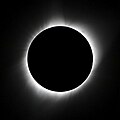20th century (AD 1901 – 2000)
- 24 January 1925
- Total Solar Eclipse: A short duration total eclipse at sunset in British waters to the north of the Hebrides. Although it nowhere touched land, the path of totality ran very close to several outlying Scottish islands, including St Kilda; the islet of Sula Sgeir experienced 99.9% totality.
- 29 June 1927
- Total Solar Eclipse: A mere 24 seconds of totality in the early morning, along a narrow track from North Wales, through Lancashire to the English north-east coast, but weather was very poor with cloud and high winds. However the Astronomer Royal's expedition to Giggleswick in North Yorkshire was amongst the few to catch sight of totality.
- 30 June 1954
- Total Solar Eclipse at Unst in the Shetland Islands, although the centre line was north of British territorial waters. A large partial eclipse was widely observed over the whole of the UK.
- 2 October 1959
- A partial eclipse visible over the whole of the United Kingdom ranging from approximately 20% in Northern Scotland to approximately 40% in South West Cornwall.
- 15 February 1961
- The United Kingdom was greeted at dawn with a large portion of the Sun covered with maximum eclipse being approximately on the horizon ranging from 85% in Northern Scotland to between 92% and 95% in Southern England.
Partial solar eclipses also occurred on 20 May 1966, 22 September 1968, 25 February 1971, 10 July 1972, 30 June 1973, 11 May 1975, 29 April 1976, 20 July 1982, 15 December 1982, 4 December 1984, 21 May 1993 and 10 May 1994. (Source: HMNAO Eclipses On-line Portal.)
- 12 October 1996
- A partial solar eclipse which covered 60% of the Sun over the British Isles.
- 11 August 1999
- Total Solar Eclipse over Cornwall and part of south Devon, partial over the rest of the United Kingdom. Totality was observable from English Channel and the island of Alderney in the Channel Islands, but was almost universally clouded out on the British mainland. A large partial eclipse was visible in the south-east of England and south Wales. Observers in various places noted birds falling silent, daylight colours turning to grey, and temperatures falling, augmented by a passing wisp of cloud at the moment of peak eclipse.
This page is based on this
Wikipedia article Text is available under the
CC BY-SA 4.0 license; additional terms may apply.
Images, videos and audio are available under their respective licenses.






